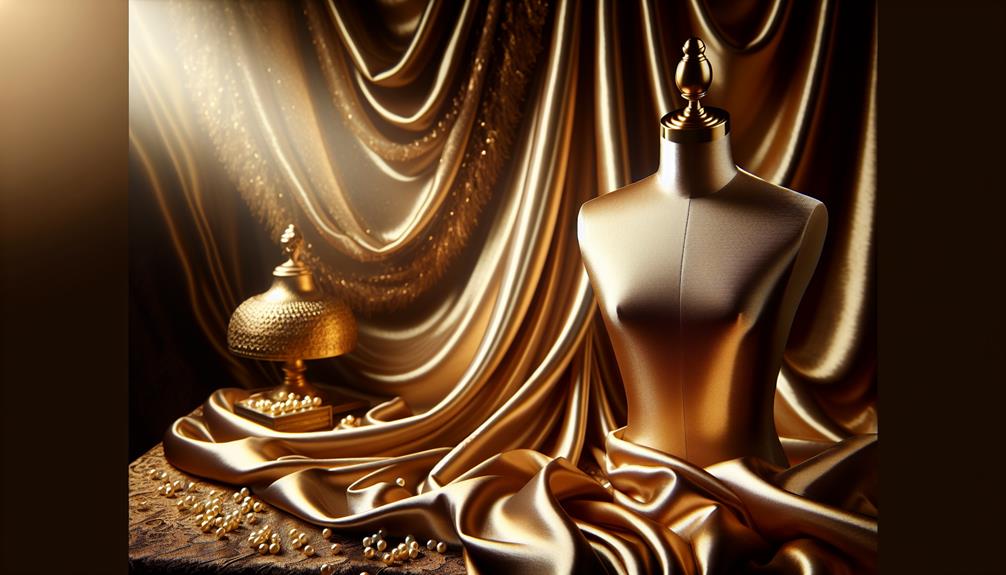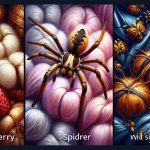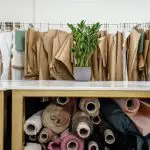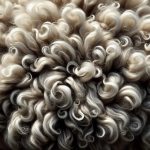I've found that Vicuña wool is one of the most expensive cloths you can find. It's super rare and comes from the Vicuña animals in South America. Harvesting their wool involves a lot of care to protect these animals and their environment. Each cloth piece is meticulously handcrafted, and its rarity drives up the price substantially. Imagine wearing something that's both a luxury and a testament to conservation efforts. Trust me, the world of expensive fabrics is fascinating, and Vicuña is just the beginning. Stick around, and you'll discover some truly incredible textiles and stories behind them.
Table of Contents
Key Takeaways
- Vicuña wool is the rarest and often considered the most expensive fabric due to its limited supply and labor-intensive production.
- Cashmere is highly valued for its softness, warmth, and exclusivity, contributing to its high cost.
- Silk is renowned for its luxurious texture and historical significance, making it a pricey fabric option.
- Guanaco wool, known for its softness and fine texture, is scarce and highly sought after in luxury markets.
- Exotic leather textiles are expensive due to the rarity of the materials, specialized tanning techniques, and strict conservation standards.
The Allure of Cashmere
Cashmere's luxurious softness has captivated fashion lovers worldwide. Its allure isn't just about how it feels; it's also about its exclusivity and the story behind the fabric. Let me break it down for you.
Cashmere comes from the undercoat of cashmere goats, which are primarily found in the mountainous regions of Mongolia, Nepal, and China. These goats have a double fleece consisting of a fine, soft undercoat and a coarser outer coat.
The process of obtaining pure cashmere is meticulous. Herders comb the goats' soft undercoat during the spring molting season. This method ensures that the fibers are collected without harming the goats. After collection, the fibers undergo a sorting process to separate the fine hairs from the coarse ones. The pure cashmere is then spun into yarn and woven or knitted into garments.
What sets cashmere apart is its warmth, lightness, and breathability. Despite its thinness, it offers much more insulation than regular wool. This makes it perfect for high-end, lightweight winter wear. Moreover, its scarcity and labor-intensive production process add to its value, making it a sought-after material in the fashion industry.
Vicuña: The Rarest Wool
Now, let's talk about vicuña, the rarest wool out there.
We'll first look at how preserving their habitat is crucial, not just for the animal but for the fabric's quality too.
Then, I'll explain how the fabric is made from these elusive creatures.
Vicuña Habitat Preservation
Preserving the habitat of the vicuña is crucial for maintaining the supply of the world's rarest wool. These graceful creatures live in the Andes Mountains, thriving in high-altitude grasslands from Peru to Argentina. Their environment is delicate; it needs protection from overgrazing and encroachment. This isn't just about keeping the scenery pretty. It's about survival.
When their habitat is secure, vicuñas can grow their fine wool without stress. This means better quality and more sustainable wool for us. I'm talking about taking steps like enforcing wildlife protection laws and promoting sustainable practices among local communities. It's a win-win: we preserve a unique ecosystem and continue to enjoy luxury wool. Let's keep those Andean highlands pristine!
Fabric Production Process
Having looked at how vital it is to protect vicuña habitats, let's explore how their rare wool is transformed into luxurious fabric. The process isn't just fascinating; it's a testament to craftsmanship and care. First, the vicuñas are gently captured and shorn during specific times to ensure their protection and welfare. The wool then undergoes a meticulous cleaning process, as any impurity affects the quality.
Here's a quick snapshot:
| Stage | Detail | Emotion Evoked |
|---|---|---|
| Shearing | Gentle and respectful | Relief and Pride |
| Cleaning | Thorough, no chemicals | Satisfaction |
| Weaving | Handled with precision | Awe and Respect |
This journey from fleece to fabric isn't just about making clothes; it's about honoring a legacy and cherishing a rare gift from nature.
Guanaco: Luxurious and Scarce
While guanaco fibers are incredibly luxurious, they're also quite scarce and expensive. Guanacos, relatives of the llama, roam wild in South America's Andes Mountains. Their wool, known for its softness and warmth, is less coarse than that of other camelids, making it highly sought after.
Harvesting this fiber isn't easy. Unlike sheep, guanacos aren't domesticated, making their wool harder to collect. It's usually gathered from wild animals, which can only be done during specific times of the year and under strict regulations to ensure their protection. This contributes significantly to its rarity and cost.
The fiber's quality is top-notch. It's lighter and warmer than many other wool types, which is why it's perfect for high-end fashion. The demand in luxury markets drives its price even higher. Designers and connoisseurs prize guanaco wool for its exceptional qualities but obtaining it requires effort and a bit of luck given the limited supply.
The Silk Road's Finest
So, let's talk about silk, a real star on the Silk Road.
I'll explain how it's made and look at the historical trade that made it famous worldwide.
It's fascinating to see how these techniques and trades shaped our history.
Silk Production Techniques
One of the most refined techniques in silk production involves the careful cultivation of silkworms on a diet of fresh mulberry leaves. I've learned that the quality of silk largely depends on these little critters getting the best possible nutrients.
After they've munched enough, they start spinning their cocoons. This is where the magic happens. The cocoons are then delicately harvested and the silk threads are carefully unwound. It's a meticulous process, requiring patience and a gentle hand.
I also found out that the environment where the silkworms grow plays a huge role. Everything from temperature to humidity is controlled to ensure the threads are strong and uniform. This level of attention is what makes silk so luxurious and expensive.
Historical Silk Trade
The Silk Road wasn't just a trade route; it was the lifeline that connected the world through the exchange of exquisite silk and other precious goods. Trading silk wasn't as simple as it sounds; it involved a complex network of merchants, camels, and perilous journeys across deserts and mountains. Here's what I found fascinating:
- Diverse Routes: The road had several branches, not just one path, connecting different kingdoms and cultures.
- Luxury and Power: Silk symbolized wealth and status, often used in royal garments and diplomatic gifts.
- Cultural Exchange: Along with silk, ideas and technologies spread, enriching societies along the way.
- Economic Impact: Silk trade was incredibly lucrative, shaping economies of entire regions.
Understanding this helps us appreciate silk's lasting value and historical significance.
Exploring Rare Linen Varieties
Delving into rare linen varieties reveals a world of luxurious and uncommon textiles. As I explore these unique fibers, I'm struck by their distinct qualities and the meticulous processes involved in their production. For instance, Belgian linen, renowned for its exceptional quality, is produced from flax grown exclusively in Belgium. The region's climate and soil composition contribute uniquely to the flax's growth, ensuring a fiber that's both strong and absorbent.
Another fascinating variety is Irish linen, known for its crisp texture and high thread count. It's not just the flax that makes Irish linen stand out, but also the traditional methods preserved by generations of craftspeople. These artisans employ age-old techniques that enhance the linen's natural qualities, making it a favorite among luxury textile enthusiasts.
Exploring further, I've come across lesser-known types like Solbiati linen, which integrates innovation with tradition. Solbiati blends its linen with other luxury materials to create fabrics that aren't only unique but also high in quality and appeal.
Understanding these rare types of linen has deepened my appreciation for the craftsmanship and heritage behind each weave. It's clear that the rarity and quality of these textiles are what mark them as some of the most sought-after in the fashion and design realms.
The Price of Quality Cotton
While exploring high-quality cotton, I've learned that its price reflects the meticulous care and extensive labor required to produce it. The journey from plant to fabric isn't simple, and the cost isn't just about the raw material itself, but also the expertise and time it takes to turn it into the soft, durable cloth we love.
Here's why quality cotton can be so pricey:
- Selective Breeding: Farmers choose only the best plants to breed, aiming for superior fiber qualities.
- Manual Harvesting: Machines can damage the fibers, so premium cotton is often picked by hand.
- Lengthy Ginning Process: Separating cotton fibers from seeds carefully preserves the fiber's length and strength.
- Specialized Weaving: High-quality cotton requires more intricate weaving techniques to produce a finer, more consistent textile.
Understanding these factors, I appreciate why a higher price tag is inevitable. It's not just fabric; it's years of innovation and careful craftsmanship. When you buy high-quality cotton, you're not only paying for a product but also for a tradition of excellence and the assurance that what you're getting is top-tier in comfort and sustainability.
Exotic Leather Textiles
Why do exotic leather textiles often carry such a high price tag?
Well, let's break it down.
First off, these leathers come from rare animals, like crocodiles, ostriches, and snakes. Since these creatures aren't as common as, say, cows, their skins are harder to come by, which jacks up the price.
Then there's the process of turning these wild skins into something you can actually use. It's not straightforward. These materials require delicate handling and specialized tanning techniques to preserve their unique textures and patterns. Each piece has to be treated with care, and that meticulous process takes time and expertise, which means more money.
Plus, let's not forget about the laws. Many exotic leathers are regulated under international conservation standards to prevent over-exploitation and protect endangered species. This legal framework means that acquiring and selling these materials involves lots of permits and inspections, adding to the costs.
The Charm of Chiffon
Now, let's talk about chiffon, a fabric that's as elegant as it's mysterious.
I'll start by exploring where chiffon comes from and how it's made.
Then, I'll share some practical tips on how to style outfits using this lightweight, flowing material.
Chiffon Fabric Origins
Chiffon, with its light and airy qualities, originated in France in the early 1700s. It's been a favorite for its elegance and delicate appearance. Here's a quick look at why it's so cherished:
- Transparency: Chiffon's sheer nature allows for layering that creates depth and texture in garments.
- Lightness: It's incredibly lightweight, making it perfect for flowy dresses.
- Drape: Chiffon has a natural drape that clings and flows gracefully with the body.
- Breathability: Despite its delicate nature, it's surprisingly breathable, ideal for summer wear.
Understanding these key features helps in appreciating the intricate craftsmanship and design thought behind using chiffon in high fashion. It's not just fabric; it's a canvas for artistry.
Chiffon Styling Tips
I often turn to chiffon when I want to add a touch of elegance to my outfit without sacrificing comfort. This lightweight fabric is perfect for creating flowy, breathable styles that work beautifully for both casual and formal settings.
When styling chiffon, I opt for a well-fitted undergarment because chiffon can be quite sheer. Pairing it with a sleek blazer or a tailored jacket can elevate the look instantly.
For a casual day out, I'll go for a chiffon blouse with denim jeans; it's simple yet chic. For evening events, a chiffon maxi dress does the trick. It's all about balancing the sheerness with solid pieces and playing with layers to achieve that perfect blend of sophistication and ease.
Mohair: A Premium Fiber
Mohair, known for its luxurious sheen and softness, is a sought-after material in high-end fashion. I've always been fascinated by how this exclusive fabric makes its way from the back of a goat to the backs of the fashion-forward. It's not just any goat, but the Angora goat that gives us this beautiful fiber. Originating from Turkey, these goats are now bred worldwide, especially in the United States and South Africa, making mohair a globally recognized luxury.
Here's why mohair stands out:
- Durability: Despite its delicate appearance, mohair is incredibly durable and resilient. It's great for garments that need to withstand wear and tear.
- Insulation: Mohair naturally regulates temperature, keeping you warm in winter and cool in summer. It's like having a natural thermostat!
- Dye-ability: It holds colors exceptionally well, giving designers flexibility to play with vibrant shades.
- Lustre: The fiber's natural luster gives fabrics a chic, radiant glow that enhances any outfit.
I've learned that the high cost of mohair is due to its manual, labor-intensive harvesting and processing methods. But for those who value quality and style, it's definitely worth it. Mohair isn't just a fabric; it's an investment in elegance and comfort.
The Opulence of Brocade
While mohair offers a blend of comfort and luxury, brocade steps it up with its rich, textured elegance. I've always been fascinated by how brocade isn't just a fabric; it's a statement. Made typically with silk, and interwoven with gold or silver threads, it's the kind of material you see in historical tapestries and upscale modern fashion. Its heavy, slightly raised designs are more than just patterns; they're art.
Brocade's process is what really ramps up its price. It's woven on a special loom that allows intricate patterns to be crafted directly into the fabric. This isn't your everyday wear but a fabric chosen for moments when you want to shine. Think grand weddings, royal gatherings, and significant cultural events. Each piece of brocade can tell a story, reflecting the traditions and skills passed down through generations.
What's even more intriguing is its versatility despite its luxuriousness. Sure, it's heavy, but it works beautifully in both traditional and contemporary fashion. It's durable too, lasting through years of use with proper care.
Pashmina: Beyond Ordinary
Pashmina shawls aren't just warm; they're a blend of luxury and centuries-old craftsmanship. When I first touched a genuine pashmina, its softness and warmth were unmistakable. What sets this fabric apart isn't just its feel, though, it's the intricate process of making it, which is steeped in tradition.
Here's why pashmina holds such a special place:
- Rare Materials: Pashmina is made from the fine undercoat fibers of the Changthangi goat, native to the cold, high-altitude regions of the Himalayas.
- Handcrafted: From combing out the fine hair to spinning it into yarn, every step is done by hand.
- Kashmiri Artisans: The skills required to weave and embroider these shawls have been passed down through generations of artisans from Kashmir.
- Limited Production: The meticulous process and limited source of the wool mean that pashmina production is quite low compared to other fabrics.
Owning a pashmina means you're part of a tradition that values meticulous detail and cultural heritage. It's more than just owning a piece of clothing; it's about preserving a piece of art. Each shawl tells a story of artisanal legacy, making it truly beyond ordinary.
The Appeal of Velvet
Velvet's luxurious texture and rich appearance have long captivated fashion and interior designers alike. There's something about its softness and subtle sheen that screams elegance. I've seen it everywhere, from the runways to the plush sofas in high-end lounges. It just adds a touch of class wherever it appears.
One thing I've noticed is that velvet isn't just about looks; it's about the feel. Running your hand over velvet fabric is a unique experience, almost like touching soft, dense fur. That tactile pleasure contributes heavily to its appeal. It's no wonder velvet often shows up in winter collections. It's not only warm but also comforting during chilly seasons.
Velvet's versatility is another big plus. It can look regal in a deep blue blazer or whimsically edgy in emerald green pants. It adapts well to various styles and occasions, making it a favorite for designers aiming for both traditional and modern vibes.
Moreover, maintaining velvet isn't as daunting as some might think. With the right care, it can last for years, looking as lush as ever. That's why investing in a velvet piece often feels worth it. It's a timeless fabric that keeps its charm, making every penny spent on it feel justified.
Frequently Asked Questions
How Do I Identify Authentic Versus Counterfeit Expensive Fabrics?
I've learned 90% of luxury fabric buyers can't spot a fake. To identify authentic materials, I check the texture, weight, and seam quality. Counterfeits often feel cheaper and show poor craftsmanship.
Are There Eco-Friendly Options Among Luxury Textiles?
Yes, there are eco-friendly luxury textiles! I've found organic silk and recycled cashmere are great options. They're sustainable without compromising on quality, offering top-tier luxury while being kind to the planet.
What Are the Latest Trends in Expensive Fabric Design?
I've explored the galaxy of fabrics, and the latest trend is all about sustainability meeting luxury. Designers are weaving eco-consciousness into their high-end fabrics, making fashion both lavish and responsible. It's absolutely groundbreaking!
How Should Expensive Fabrics Be Stored to Preserve Quality?
I store my expensive fabrics in a cool, dry place, avoid direct sunlight, and use acid-free tissue paper to prevent fading and deterioration. Proper storage is key to maintaining their quality and longevity.
Where Can I Get Custom-Tailored Outfits Using These Fabrics?
I've found that high-end boutiques and bespoke tailors in major cities often offer custom-tailoring services for luxury fabrics. They're great for crafting unique, perfectly fitting garments tailored to your personal style.
- How Durable Is Chiffon? - April 23, 2024
- Which Cloth Is Very Expensive? - April 23, 2024
- How Can You Tell if Chiffon Is Silk? - April 23, 2024







